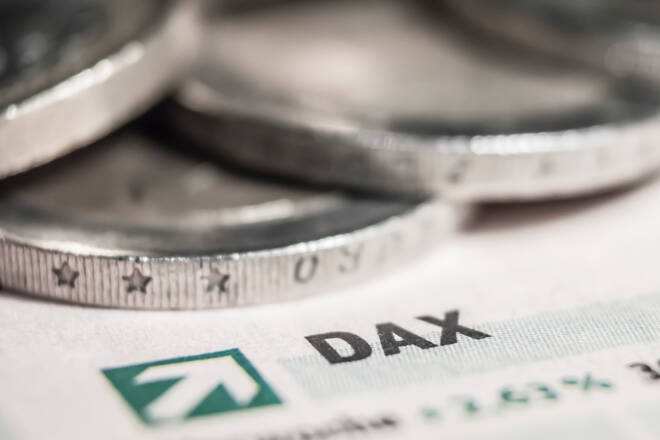Advertisement
Advertisement
European Equities: Economic Data May Add to the Negativity as Europe Shuts Down
By:
It was another day in the deep red as central bank action spooked the markets. As the virus spreads, it may not just be the 1st quarter that is a write-off...
Economic Calendar:
Tuesday, 17th March
German ZEW Current Conditions (Mar)
German ZEW Economic Sentiment (Mar)
Eurozone ZEW Economic Sentiment (Mar)
Eurozone Wages (YoY) (Q4)
Wednesday, 18th March
Eurozone Core CPI (YoY) (Feb) Final
Eurozone CPI (YoY) (Feb) Final
Eurozone CPI (MoM) (Feb)
Eurozone Trade Balance (Jan)
Friday, 20th March
German PPI (MoM) (Feb)
The Majors
It was a particularly bearish start to the week, with the European majors seeing deep red on Monday. The CAC40 led the way down, sliding by 5.75%, with the DAX30 and EuroStoxx600 falling by 5.31% and 4.86% respectively.
While economic data out of the Eurozone had a muted impact on the majors, monetary policy and stats out of China spooked the majors.
Ahead of the Asian open, the FED slashed interest rates by 50 basis points to a target range of 0 to 0.25%. The FED also launching a bazooka $700bn QE program to add further support to the U.S economy.
U.S President Trump had spoken over the weekend, boasting of a likely surge in the U.S equity markets on Monday. The FED’s aggressive move was likely behind the forecast, which didn’t consider how investors would react to such an aggressive move…
The Stats
It was a quiet day on the Eurozone economic calendar on Monday. Key stats were limited to finalized February inflation figures out of Italy.
Unsurprisingly, the stats had a muted impact as investors reacted, not only to the FED move but the shutdown in Europe.
From the U.S, the NY Empire State Manufacturing Index did very little to move the dial. The Index slid from 12.90 to -21.50. in March.
Earlier in the day, economic data out of China certainly contributed to the risk aversion…
Industrial production tumbled by 13.5% in February, year-on-year, following a 6.9% increase in January. While the numbers were particularly dire, the sizeable miss by economists was more alarming. Economists had forecast a 1.5% increase, reflecting just how off the markets are from understanding the impact of the virus on the global economy.
Fixed asset investments slumped by 24.5% in February, following a 5.4% rise in January, with the unemployment rate jumping from 5.2% to 6.2%.
The Market Movers
For the DAX: it was a particularly bearish day the auto sector. BMW and Volkswagen led the way down, with losses of 16.06% and 16.05% respectively. Things were not much better for Continental and Daimler which slid by 13.57% and 15.25% respectively.
It was also a bearish day for the banks, with Commerzbank and Deutsche Bank tumbling by 7.30% and 10.59% respectively.
Deutsche Lufthansa reversed Friday’s 10.14% gain with a 13.66% slide as governments globally continued to shut down borders.
From the CAC, it was a particularly bearish day for the banks. Soc Gen led the way down, slumping by 15.33%. BNP Paribas and Credit Agricole were close behind with losses of 13% and 11.43% respectively.
The auto sector also took a hit, with Peugeot and Renault sliding 7.19% and 12.87% respectively.
Air France-KLM joined its peers in the red, with a 10.11% loss at the start of the week.
On the VIX Index
The VIX was back into the green as panic gripped the global financial markets, with a 42.99% surge delivering the 6th day in the green out of 8. Reversing a 23.37% slide from Friday, the VIX ended the day at 82.7.
The fallout from the FED’s rate emergency rate cut and fresh QE and particularly dire data out of China did the damage.
By historical standards, the fear gauge hit its highest level since a historically high 96.4 in October 2008, which may be the only comfort for investors.
On the day, the S&P500 triggered its circuit breakers at the open before continuing its downward spiral to end the day down 11.98%. The loss on the day saw the S&P500 fall through support at 2,400.
Things were worse for the Dow, which tumbled by 12.93% and the NASDAQ, which slumped by 12.32. While the FED certainly didn’t help the cause by not waiting until Wednesday, the spread of the coronavirus does place a grim outlook on the U.S and global economies. Any hopes of a rebound in the 2nd quarter look dashed as governments go into shutdown mode.
The Day Ahead
It’s a relatively busy day ahead on the Eurozone economic calendar. Key stats due out later this morning include ZEW economic sentiment figures for Germany and the Eurozone and Eurozone wage growth figures.
4th quarter wage growth figures are likely to have a muted impact, with the markets more interested in sentiment towards the coronavirus. It wouldn’t be a surprise, however, if sentiment slumps…
As things stand, there’s little from the economic calendar that can ease negative sentiment, which will limit any influence from any positive numbers.
In the futures markets, at the time of writing, the DAX was down by 9.5 points, while the Dow was up by 336 points as the markets lick its wounds from Monday’s rout.
About the Author
Bob Masonauthor
With over 28 years of experience in the financial industry, Bob has worked with various global rating agencies and multinational banks. Currently he is covering currencies, commodities, alternative asset classes and global equities, focusing mostly on European and Asian markets.
Advertisement
